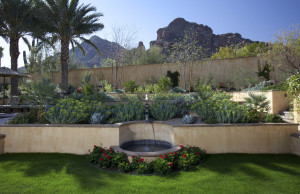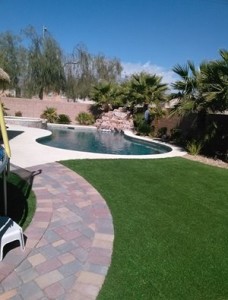Sep
Fall Overseeding and Your Lawn
The days are getting shorter and the heat is starting to die down a little as we enter the fall season. With fall comes the onset of overseeding in many parts of the country and the West Coast is no different. For those new to overseeding let me give you a brief definition. Overseeding is simply the process of seeding a cool season grass into your warm season turfgrass in order to maintain winter color. This is not a mandatory process if you have grass, but it is one of the options that are out there for homeowners and professionals.
There are a few options during the fall months to take care of your lawn, and without question the most popular is to overseed. Outside of overseeding you have the option of using turf colorant such as Endurant to give your dormant grass a nice green appearance. Or you can just let your lawn go dormant for the winter months (brown can be the new green!). There is no right or wrong approach, so decide what you would like to do as the temperatures begin to drop over the coming weeks.
If you will be letting your lawn go dormant it will stay fairly green until the first hard frost which is around Thanksgiving and will start to green up in late March. If you have a paspalum lawn you can usually get through the month of December with a green lawn and it will start greening up in early March.
I’m going to go over the step by step approach to overseeding so everyone is on the same page. In my last blog I discussed some ways to start prepping your lawn in the weeks leading up to overseeding so if you already followed those you can skip to step number 3. If you have not started prepping there is no need to panic because there is plenty of time to prep correctly and overseed your winter lawn. (Click here to watch Mr. Wisegrass’ latest video on overseeding!)
We’re still too hot to overseed, but as the night time temperatures start to cool you will get closer to the seeding window. The optimal temperature is in the high 60’s at night for a few days. This is usually around the first week of October, but could be sooner depending on where you live. Once temperatures are in this range you have 5-6 weeks to complete the overseeding process.
- Cut back your water just enough to keep your bermudagrass/paspalum alive. There is no need to have a lush lawn going into the overseed season. Stop applying any warm season lawn fertilizers and save your money for cool season fertilizers.
- Raise up the height of your lawn by 30%. You do this so when you scalp the lawn it is not being mowed down to the dirt, instead you’re scalping to a manageable height for the turf and it will not cause any injury to the turf in the spring.
- Rent a verticut or dethatcher. These can be found at Home Depots that rent equipment and several other locations like A to Z Rental. You don’t need to rent this for anymore than a half day unless you have an extremely large lawn. This is a power driven machine and the process is as quick as mowing your lawn.
- Set the verticut/dethatcher to about a ½” above the ground so you’re not pulling out roots, you’re simply opening up the grass plant. If you did not do this during the summer months you’re likely going to have a lot of clippings. No need to worry about the amount of dead grass and thatch you’re removing as long as the machine is not pulling up the roots.
- Rake or mow up the clippings. The lawn mower works really well for picking up the grass. Next set the verticut/dethatcher a touch lower and do the same process in a different direction. This will open up the dense turf canopy and allow the seed to get into the grass plant.
- Mow the clippings again. After the clippings have been cleaned up set your mower to ¾” or ½” if you have a reel mower and scalp the lawn. You don’t need to go any lower than this since it’s not about how short the lawn is, it’s about keeping the turf canopy open. The only reason you’re scalping is to keep the warm season grass from competing with the ryegrass seed.
- After the lawn has been scalped do one final check to make sure the turf canopy is still open so the seed can get down into the grass plant. If it is too tight lightly run the verticut/dethatcher one more time to open the turf up.
- As soon as the lawn is cleaned up you can go ahead and apply your starter fertilizer. I like to use Soil Burst 4-0-6. This is available online at www.westcoastturf.com. If you can’t find the Soil Burst you can use 16-20-0, 6-20-20, or 11-52-0 to get your lawn started.
- I like to keep my rocks and edges clean so I use a drop spreader and apply BOBSeed perennial ryegrass at 10 pounds per 1000 SF around the perimeter of the lawn first. I do two passes to ensure the rotary spreader will not throw seed into the rocks. This is not necessary but it will keep the ryegrass from invading undesirable areas all winter.
- Next apply your BOBSeed perennial ryegrass with a rotary spreader at 10 pounds per 1000 SF to the remainder of the lawn. If you want the best coverage you should apply 5 pounds per 1000 SF in two directions. This is always the best approach but again not necessary.
- You will have some seed on top of the grass surface but the majority should be inside the grass plant if you prepped your lawn correctly and opened up the canopy.
- Some people cover their seed with mulch but you can save your time, money and the smell in your yard because this isn’t necessary. Mulch allows the seed to maintain moisture and keeps the heat in the plant but if you’re seeding in September/October there is plenty of heat. You don’t need to worry about the moisture either. Mulch doesn’t prevent birds from eating your seed and even if they do eat some you have already applied plenty of seed with the 10 pound/1000 SF rate. If you live near a golf course you will notice that none of them cover the courses with mulch and the seed comes up really well. It would cost a fortune in labor and material to cover 60+ acres.
- Set your sprinklers to run at 8am, 11am, 2pm, and 5pm. The sprinklers don’t need to run anymore than 7-10 minutes. I give a range because some people have low flow nozzles. They should run every day at this schedule for the first two weeks after the seed has been dropped.
- After 10-14 days you should have a really good stand of ryegrass and now it is time to apply your second fertilizer application. You can either reapply the Soil Burst 5-15-10 or go with one of the products I mentioned in step 8. Make sure you water in the fertilizer for 10 minutes after you apply it.
- You can mow your lawn after two weeks when the ryegrass reaches 1 ½ to 2”.
- After two weeks you can change your sprinklers to one time daily for 15-20 minutes early in the morning. After four weeks you can start to skip days in between watering and after six weeks you should be watering no more than every 3-4 days with a deep watering cycle. If you get runoff then make sure to do a cycle/soak where the sprinklers run for 20 minutes, take an hour off and then run 20 minutes or so more. You always want to water deep and infrequently to ensure proper root growth.
- Finally apply your third fertilizer application to make sure the lawn is healthy going into the winter months. I like to use 21-7-14 at this time of the year. During the cool winter months a foliar fertilizer is best to keep the lawn green and should be applied monthly.
I know, I know—that’s a lot of steps. Most of them take 1-2 minutes so fear not this is an easy process. Overseeding will cost the average homeowner with 1000 SF of turf around $30-$35 for a good quality seed, $50-$75 for a verticutter, $20-$30 in fertilizer, and labor. Don’t skimp on the seed you buy– you won’t be happy during the winter if you do. We sell 50 pound bags of seed at our farm in Scottsdale, Arizona (11803 E. McDonald Dr.). The bags are $64.99 for Blackcat and $74.99 for GrandSlam. If you’re in California you can call our office at 1-888-873-TURF and set up a pickup at one of our many sod farms or you can have it delivered from www.westcoastturf.com.
If you have any other questions please hit the “Ask Jay” button at the top right of this page.
Happy overseeding!
Jay




